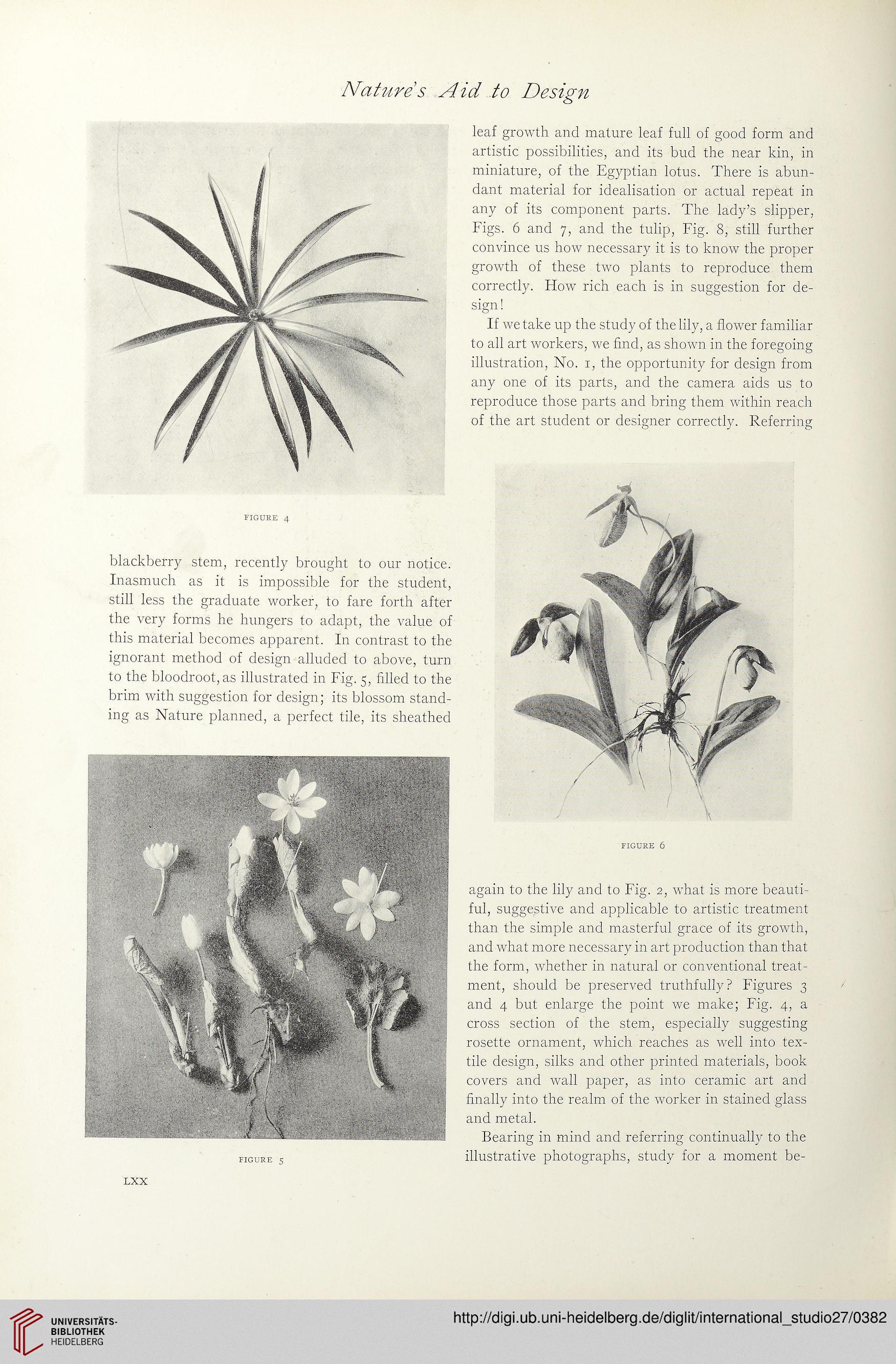Nature s Aid to Design
FIGURE 4
blackberry stem, recently brought to our notice.
Inasmuch as it is impossible for the Student,
still less the graduate worker, to fare forth after
the very forms he hungers to adapt, the value of
this material becomes apparent. In contrast to the
ignorant method of design alluded to above, turn
to the bloodroot, as illustrated in Fig. 5, filled to the
brim with Suggestion for design; its blossom Stand-
ing as Nature planned, a perfect tile, its sheathed
FIGURE 5
leaf growth and mature leaf full of good form and
artistic possibilities, and its bud the near kin, in
miniature, of the Egyptian lotus. There is abun-
dant material for idealisation or actual repeat in
any of its component parts. The lady’s slipper,
Figs. 6 and 7, and the tulip, Fig. 8, still further
convince us how necessary it is to know the proper
growth of these two plants to reproduce them
correctly. How rieh each is in Suggestion for de-
sign !
If we take up the study of the lily, a flower familiär
to all art workers, we find, as shown in the foregoing
illustration, No. 1, the opportunity for design from
any one of its parts, and the camera aids us to
reproduce those parts and bring them within reach
of the art Student or designer correctly. Referring
FIGURE 6
again to the lily and to Fig. 2, what is more beauti-
ful, suggestive and applicable to artistic treatment
than the simple and masterful grace of its growth,
and what more necessary in art production than that
the form, whether in natural or conventional treat-
ment, should be preserved truthfully ? Figures 3
and 4 but enlarge the point we make; Fig. 4, a
cross section of the stem, especially suggesting
rosette Ornament, which reaches as well into tex-
tile design, silks and other printed materials, book
covers and wall paper, as into ceramic art and
finally into the realm of the worker in stained glass
and metal.
Bearing in mind and referring continually to the
illustrative photographs, study for a moment be-
LXX
FIGURE 4
blackberry stem, recently brought to our notice.
Inasmuch as it is impossible for the Student,
still less the graduate worker, to fare forth after
the very forms he hungers to adapt, the value of
this material becomes apparent. In contrast to the
ignorant method of design alluded to above, turn
to the bloodroot, as illustrated in Fig. 5, filled to the
brim with Suggestion for design; its blossom Stand-
ing as Nature planned, a perfect tile, its sheathed
FIGURE 5
leaf growth and mature leaf full of good form and
artistic possibilities, and its bud the near kin, in
miniature, of the Egyptian lotus. There is abun-
dant material for idealisation or actual repeat in
any of its component parts. The lady’s slipper,
Figs. 6 and 7, and the tulip, Fig. 8, still further
convince us how necessary it is to know the proper
growth of these two plants to reproduce them
correctly. How rieh each is in Suggestion for de-
sign !
If we take up the study of the lily, a flower familiär
to all art workers, we find, as shown in the foregoing
illustration, No. 1, the opportunity for design from
any one of its parts, and the camera aids us to
reproduce those parts and bring them within reach
of the art Student or designer correctly. Referring
FIGURE 6
again to the lily and to Fig. 2, what is more beauti-
ful, suggestive and applicable to artistic treatment
than the simple and masterful grace of its growth,
and what more necessary in art production than that
the form, whether in natural or conventional treat-
ment, should be preserved truthfully ? Figures 3
and 4 but enlarge the point we make; Fig. 4, a
cross section of the stem, especially suggesting
rosette Ornament, which reaches as well into tex-
tile design, silks and other printed materials, book
covers and wall paper, as into ceramic art and
finally into the realm of the worker in stained glass
and metal.
Bearing in mind and referring continually to the
illustrative photographs, study for a moment be-
LXX





